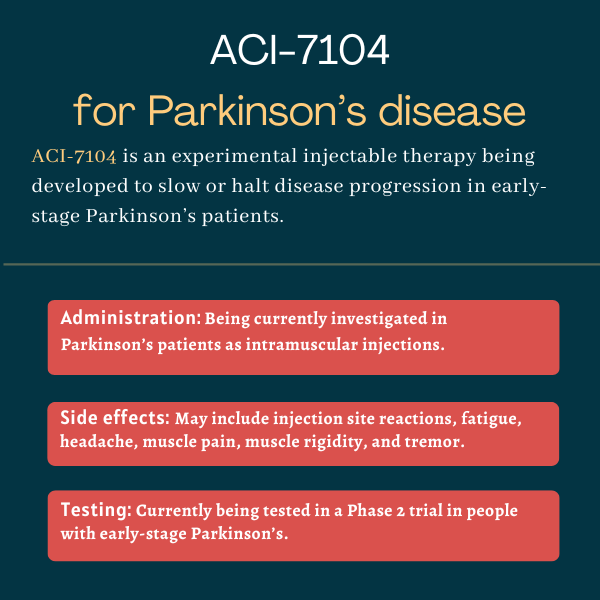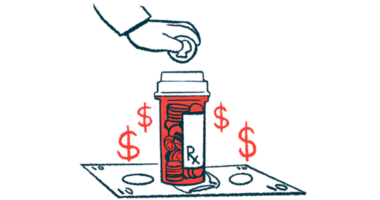ACI-7104 for Parkinson’s disease
Last updated June 14, 2024, by Marta Figueiredo, PhD

What is ACI-7104 for Parkinson’s disease?
ACI-7104, also known as ACI-7104.056, is an experimental injectable vaccine designed to slow or prevent neurodegeneration in people with early Parkinson’s disease.
The therapy’s predecessor, known as Affitope PD01A, was originally developed by Affiris and acquired by AC Immune in 2021, which is now advancing the clinical development of its optimized formulation, ACI-7104.
Therapy snapshot
| Treatment name: | ACI-7104 |
| Administration: | Being tested in Parkinson’s as injections given directly into the muscle (intramuscular injections) |
| Clinical testing: | Now in a Phase 2 clinical trial for early Parkinson’s |
How does ACI-7104 work in Parkinson’s disease?
Parkinson’s is caused by the progressive damage and death of neurons in the brain that produce dopamine, a major chemical messenger that is essential for motor control.
A hallmark of Parkinson’s is the production of a misfolded alpha-synuclein protein that is prone to form toxic clumps inside neurons that spread throughout the brain. These aggregates are thought to contribute to neurodegeneration and Parkinson’s progression.
During the aggregation process, single units of the alpha-synuclein protein begin to clump together into chain-like structures called oligomers, which can spread and grow to form fibrils, or long and thread-like fibers. Research indicates alpha-synuclein oligomers are the main drivers of neurotoxicity and neuroinflammation in Parkinson’s.
ACI-7104 is an optimized vaccine formulation designed to prompt the immune system to produce antibodies against alpha-synuclein oligomers, while generally sparing single protein units.
It consists of a lab-made small protein fragment that mimics a section of the alpha-synuclein protein that can be recognized by the immune system. The original protein sequence is mutated and coupled with other molecules to boost the immune response against it.
By triggering an immune response against alpha-synuclein oligomers, ACI-7104 should promote the clearance and breakdown of these toxic clumps, preventing further clumping and helping to slow or halt Parkinson’s progression.
How will ACI-7104 be administered in Parkinson’s disease?
In clinical trials, ACI-7104’s predecessor vaccine was injected under the skin, or subcutaneously, in the upper arm at 15 and 75 micrograms. The participants received four injections of the experimental vaccine once a month after which they were followed for a year. They were then given two booster shots separated by about one year.
In the ongoing Phase 2 trial, ACI-7104 is being administered via intramuscular injections at predefined times and at up to three doses for nearly 1.5 years.
ACI-7104 in Parkinson’s disease clinical trials
In a Parkinson’s mouse model, ACI-7104’s predecessor Affitope PD01A boosted the production of anti-alpha-synuclein antibodies, reduced protein clumps in neurons, neurodegeneration, and motor and cognitive deficits.
Based on these promising findings, Affiris launched a Phase 1 clinical program to test the experimental vaccine in people with early-stage Parkinson’s. It consisted of a first-in-human Phase 1 study, called AFF008 (NCT01568099), that was followed by three extension studies: AFF008E (NCT01885494), AFF008A (NCT02216188), and AFF008AA (NCT02618941).
Phase 1 program
The initial AFF008 study evaluated the safety and tolerability of Affitope PD01A in 32 adults, aged 45-65 years, with early-stage Parkinson’s and a diagnosis within the past four years.
Participants, enrolled at a single site in Vienna, were randomly assigned to either one of two doses of the vaccine (15 or 75 micrograms; 24 patients), given through four monthly subcutaneous injections in their upper arms — or no treatment (eight patients). All were allowed to continue standard Parkinson’s treatment and were followed for about a year.
Those completing the trial were followed for 39 more weeks, or nearly nine months, without additional vaccination in the AFF008E extension study. The patients who received the experimental vaccine were given the choice to enter two consecutive extension studies where they would receive one booster vaccine in each.
In the Phase 1b AFF008A extension trial, 22 participants were randomly assigned to receive a single booster vaccination (at 15 or 75 micrograms) and were followed for about six months. Up to eight patients not receiving the vaccine were also allowed in the study.
About nearly a year after the first booster, the patients in the treatment groups received a second booster vaccine, at 75 micrograms, and were followed for one year within the Phase 1b AFF008AA extension study. This trial also allowed up to six patients to enroll as an untreated control group.
Of the 24 patients who received the four vaccinations in the first trial, three subsequently withdrew from the program and the remaining 21 (87%) received all six vaccinations.
Results from all four trials showed that both doses of Affitope PD01A were generally well tolerated, meeting the main goal of the Phase 1 clinical program.
There were no treatment-related serious adverse events or events that led to withdrawal. Most adverse events were deemed unrelated to the treatment, except for expected local injection-site reactions, which were temporary. There also were no signs of dose-dependent safety concerns or cumulative toxicity with booster injections.
Patient samples showed that the vaccine, at either dose, triggered the production of antibodies against alpha-synuclein, which were detected in the blood but and in the cerebrospinal fluid (CSF) that surrounds the brain and spinal cord. This meant the clinical program met its key secondary goal.
Maximum antibody levels in the blood were reached at week 12, or about three months, after three monthly vaccinations, and slowly dropped over time. The first booster injection resulted in antibody levels that were significantly higher than those achieved with the first four monthly vaccinations.
This confirmed that the first injections effectively promoted a memory effect in the patients’ immune system, which let it respond faster to threats in case of re-exposure. The second booster, given about a year later, maintained those high antibody levels until the study’s end.
The higher vaccine dose was also associated with a 51% reduction in the CSF levels of alpha-synuclein oligomers, but not total alpha-synuclein, after the four initial shots, confirming successful target engagement of the newly formed antibodies to toxic protein clumps.
While tests that assessed motor and nonmotor skills didn’t show changes after Affitope PD01A treatment, these studies were not designed or powered to detect changes in Parkinson’s symptoms.
Ongoing Phase 2 trial
Building on the strong Phase 1 data of the predecessor vaccine, AC Immune launched the Phase 2 trial VacSYn (NCT06015841) that is evaluating ACI-7104’s safety, tolerability, immunogenicity, and pharmacodynamics in up to 150 adults with early-stage Parkinson’s.
Immunogenicity refers to a therapy’s ability to trigger immune responses, while pharmacodynamics makes up its effects on the body.
In the study’s first part, which started dosing in November 2023, up to three consecutive groups of patients will be randomly assigned to receive intramuscular injections of either ACI-7104 or a placebo, at predefined times for 74 weeks, or nearly 1.5 years.
If safety data from the first patient group suggest the tested dose may be increased without causing intolerable adverse events, the second group will open and a higher dose will be evaluated in additional patients. The same rationale will be used for the possible opening of a third, higher-dose group.
The resulting safety and efficacy findings, including changes in the levels of anti-alpha-synuclein antibodies and alpha-synuclein-related biomarkers in body fluids, will help determine the optimal ACI-7104 dose to be tested in a larger number of patients in the trial’s second part.
Part two’s goal is to generate proof-of-concept evidence of the vaccine’s benefit in early Parkinson’s patients. Besides the therapy’s safety, the researchers will monitor the progression of motor and nonmotor symptoms with validated measures and assess changes in imaging, fluid, and digital biomarkers.
Common side effects of ACI-7104
The most common side effects reported with ACI-7104 in clinical trials include:
- injection site reactions
- fatigue
- headache
- muscle pain
- muscle rigidity
- tremor
Parkinson’s News Today is strictly a news and information website about the disease. It does not provide medical advice, diagnosis, or treatment. This content is not intended to be a substitute for professional medical advice, diagnosis, or treatment. Always seek the advice of your physician or other qualified health provider with any questions you may have regarding a medical condition. Never disregard professional medical advice or delay in seeking it because of something you have read on this website.
Recent Posts
- Understanding the importance of advance directives
- New study reveals why exercise is vital for Parkinson’s brain health
- GT-02287 boosts enzyme activity in Parkinson’s brain: Trial data
- Dealing with scrutiny when symptoms of Parkinson’s are invisible
- Grant backs new imaging approach for earlier Parkinson’s detection
Related articles







